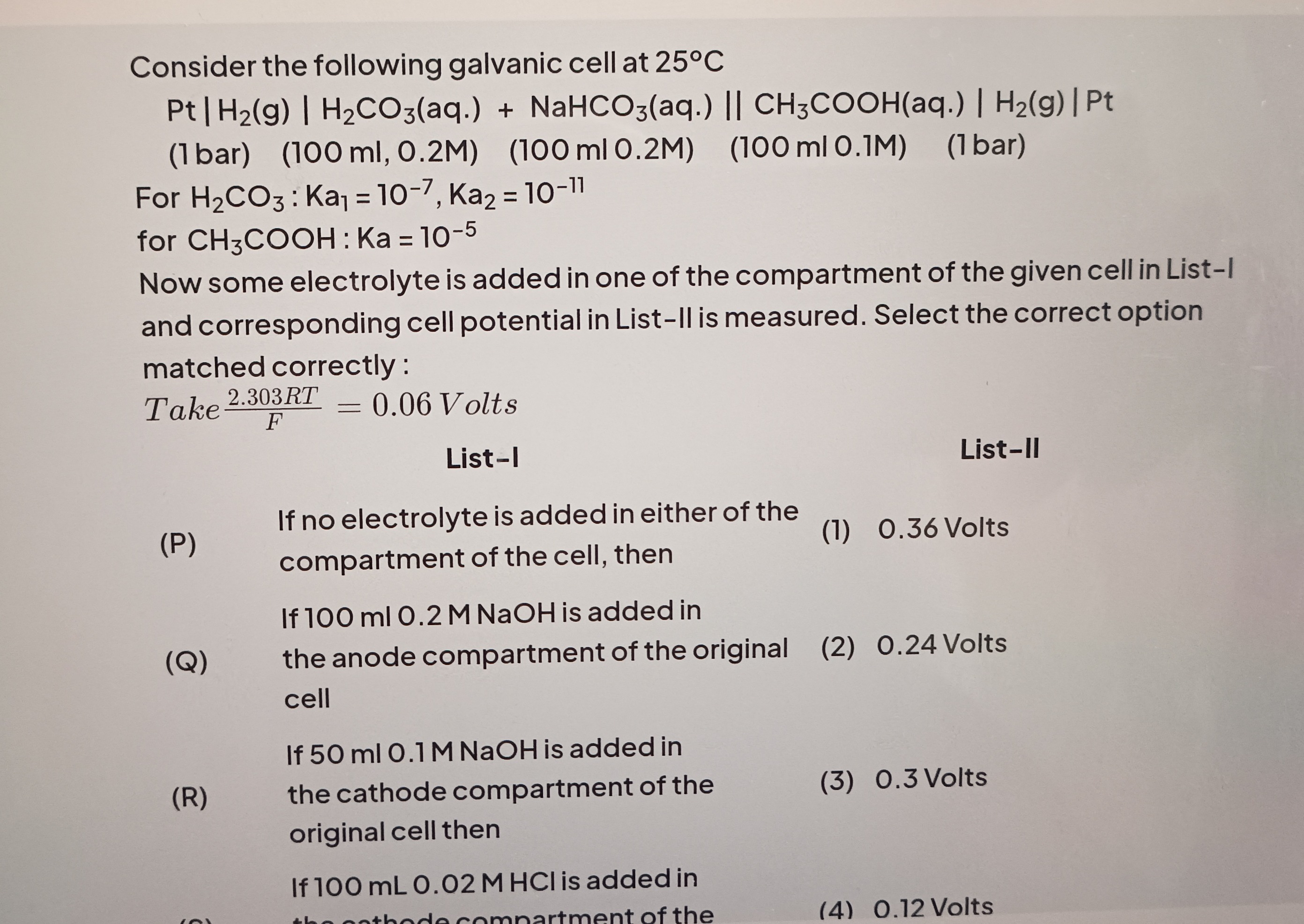Question
Question: Consider the following galvanic cell at 25°C $Pt | H_2(g) | H_2CO_3(aq.) + NaHCO_3(aq.) || CH_3COOH...
Consider the following galvanic cell at 25°C
Pt∣H2(g)∣H2CO3(aq.)+NaHCO3(aq.)∣∣CH3COOH(aq.)∣H2(g)∣Pt (1 bar) (100 ml, 0.2M) (100 ml 0.2M) (100 ml 0.1M) (1 bar) For H2CO3:Ka1=10−7,Ka2=10−11 for CH3COOH:Ka=10−5 Now some electrolyte is added in one of the compartment of the given cell in List-l and corresponding cell potential in List-ll is measured. Select the correct option matched correctly: TakeF2.303RT=0.06Volts
| List-l | List-II | ||
|---|---|---|---|
| (P) | If no electrolyte is added in either of the compartment of the cell, then | (1) | 0.36 Volts |
| (Q) | If 100 ml 0.2 M NaOH is added in the anode compartment of the original cell | (2) | 0.24 Volts |
| (R) | If 50 ml 0.1 M NaOH is added in the cathode compartment of the original cell then | (3) | 0.3 Volts |
| (S) | If 100 mL 0.02 M HCl is added in the cathode compartment of the | (4) | 0.12 Volts |

(P)-(2), (Q)-(1), (R)-(4), (S)-(3)
(P)-(2), (Q)-(1), (R)-(4), (S)-(3)
Solution
The cell is a concentration cell with hydrogen electrodes:
Pt∣H2(g,1 bar)∣Anode solution∣∣Cathode solution∣H2(g,1 bar)∣Pt
The cell potential is given by Ecell=Ecathode−Eanode. For a hydrogen electrode, E=−F2.303RTpH. Given F2.303RT=0.06 Volts. Ecell=−0.06pHcathode−(−0.06pHanode)=0.06(pHanode−pHcathode).
Initial conditions: Anode compartment: 100 ml 0.2 M H2CO3 + 100 ml 0.2 M NaHCO3. This is a buffer solution of H2CO3 and HCO3−. Moles of H2CO3=0.2M×0.1L=0.02 mol. Moles of NaHCO3=0.2M×0.1L=0.02 mol (providing HCO3−). Total volume = 200 ml = 0.2 L. Concentrations: [H2CO3]=0.20.02=0.1M, [HCO3−]=0.20.02=0.1M. H2CO3 is a weak acid with Ka1=10−7. pKa1=7. Using the Henderson-Hasselbalch equation: pHanode=pKa1+log[H2CO3][HCO3−]=7+log0.10.1=7.
Cathode compartment: 100 ml 0.1 M CH3COOH. Moles of CH3COOH=0.1M×0.1L=0.01 mol. Volume = 100 ml = 0.1 L. Concentration: [CH3COOH]=0.1M. CH3COOH is a weak acid with Ka=10−5. [H+]cathode=Ka×[CH3COOH]=10−5×0.1=10−6=10−3M. pHcathode=−log(10−3)=3.
(P) No electrolyte is added. pHanode=7, pHcathode=3. Ecell=0.06(7−3)=0.06×4=0.24 V. (P) matches with (2).
(Q) 100 ml 0.2 M NaOH is added in the anode compartment. Initial moles: H2CO3=0.02, HCO3−=0.02. Added NaOH moles = 0.2M×0.1L=0.02 mol. Reaction: H2CO3+OH−→HCO3−+H2O. Moles after reaction: H2CO3=0.02−0.02=0, OH−=0.02−0.02=0, HCO3−=0.02+0.02=0.04. Total volume = 200 ml + 100 ml = 300 ml = 0.3 L. The solution contains 0.04 mol of HCO3− in 0.3 L. This is a solution of NaHCO3. HCO3− is an amphoteric species. The pH of a solution of NaHCO3 can be approximated by pH≈2pKa1+pKa2 for H2CO3. pKa1=7, pKa2=11. pHanode≈27+11=9. The cathode compartment is unchanged, pHcathode=3. Ecell=0.06(9−3)=0.06×6=0.36 V. (Q) matches with (1).
(R) 50 ml 0.1 M NaOH is added in the cathode compartment. Initial moles: CH3COOH=0.01. Added NaOH moles = 0.1M×0.05L=0.005 mol. Reaction: CH3COOH+OH−→CH3COO−+H2O. Moles after reaction: CH3COOH=0.01−0.005=0.005, OH−=0, CH3COO−=0.005. Total volume = 100 ml + 50 ml = 150 ml = 0.15 L. The solution is a buffer containing CH3COOH and CH3COO−. [CH3COOH]=0.150.005=301M. [CH3COO−]=0.150.005=301M. Ka for CH3COOH=10−5, pKa=5. pHcathode=pKa+log[CH3COOH][CH3COO−]=5+log1/301/30=5+log(1)=5. The anode compartment is unchanged, pHanode=7. Ecell=0.06(7−5)=0.06×2=0.12 V. (R) matches with (4).
(S) 100 mL 0.02 M HCl is added in the cathode compartment. Initial moles: CH3COOH=0.01. Added HCl moles = 0.02M×0.1L=0.002 mol. HCl is a strong acid. It will react with the conjugate base if present, but the original cathode solution is just a weak acid. Adding a strong acid to a weak acid solution will suppress the dissociation of the weak acid and the pH will be primarily determined by the strong acid, unless the concentration of the strong acid is much lower than the weak acid's Ka or the concentration of the weak acid. Total volume = 100 ml + 100 ml = 200 ml = 0.2 L. Concentration of added HCl in the mixture = 0.2L0.002mol=0.01M. The cathode solution contains 0.1M CH3COOH and 0.01M HCl. HCl is a strong acid, so it dissociates completely: HCl→H++Cl−. This contributes 0.01M of H+. CH3COOH⇌H++CH3COO−, Ka=10−5. Let x be the concentration of CH3COOH that dissociates. [CH3COOH]=0.1−x. [H+]=0.01+x. [CH3COO−]=x. Ka=[CH3COOH][H+][CH3COO−]=0.1−x(0.01+x)x=10−5. Since Ka is small and we are adding a strong acid, x is expected to be small. Assume 0.1−x≈0.1 and 0.01+x≈0.01. 0.10.01×x≈10−5⇒0.1x≈10−5⇒x≈10−4. This value of x (10−4) is small compared to 0.01 and 0.1, so the approximation is valid. [H+]cathode=0.01+x=0.01+10−4=0.0101M. pHcathode=−log(0.0101)≈−log(10−2)=2. Using a calculator: pHcathode=−log(0.0101)≈1.9956≈2. The anode compartment is unchanged, pHanode=7. Ecell=0.06(7−2)=0.06×5=0.30 V. (S) matches with (3).
Summary of matches: (P) - (2) (Q) - (1) (R) - (4) (S) - (3)
The correct option matching (P)-(Q)-(R)-(S) with (1)-(2)-(3)-(4) is (2)-(1)-(4)-(3).
